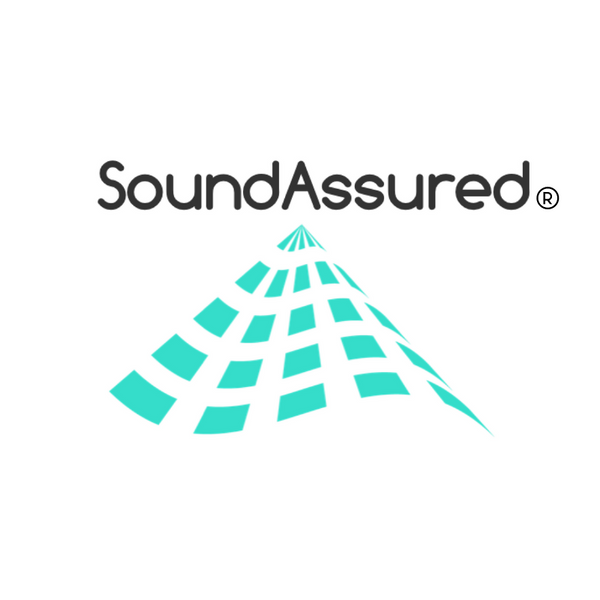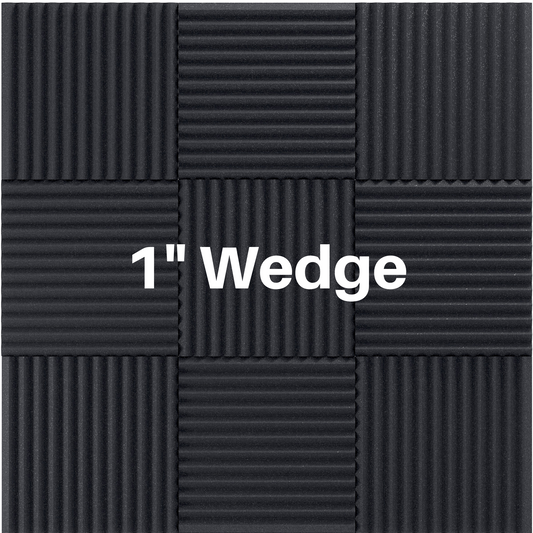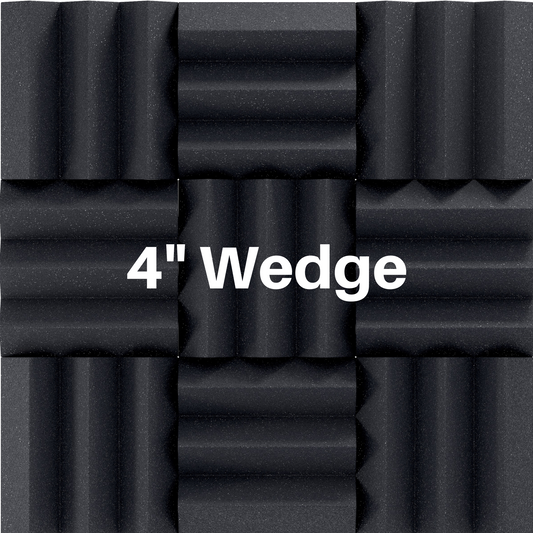Where Should Bass Traps Be Placed? - Bass Trap FAQ
Share
In this post we are going to talk all about bass traps. Where to install them, how to install them, what they are used for, what they are not used for, and much more! If you want to learn all about bass traps you are in the right place!
Here is a roadmap to the questions we answer in this post:
- Where to install bass traps?
- How to install bass traps?
- Why bass traps in corners?
- Do bass traps have to be floor to ceiling?
- Do bass traps work for outside noise?
- Which bass traps to buy?
- Are bass traps necessary?
- Why are bass traps so expensive?
- Do you need bass traps in a vocal booth?
Where to install bass traps?
Bass traps should be placed in locations of your room where low frequency sounds tend to build up. These areas can cause acoustic problems such as resonances, standing waves, and other unwanted sound reflections.
For the most part, bass traps are more effective when placed in the corners of a room, because this is where low frequency sound waves tend to accumulate the most. Also, bass traps can be placed along walls, near the ceiling, or on walls and ceilings in certain situations.



It is important to keep in mind that the placement of bass traps may vary depending on the specific acoustic problems in a room, as well as the rooms characteristics. Therefore, it is recommended to consult with a professional acoustician or audio engineer to determine the best placement for bass traps in a specific space.

How to install bass traps?
Hanging acoustic foam bass traps is a straightforward process, but it requires some attention to detail to ensure they are placed correctly. Here are some simple steps to follow when installing acoustic foam bass traps:
Step 1 - Determine the best placement: As mentioned earlier, the best placement for bass traps depends on the acoustic properties of the room. Generally, they should be placed in the corners of the room, where low-frequency sounds tend to accumulate.
Step 2 - Clean the surface: Before installing the bass traps, make sure the surface where you plan to mount them is clean and free of any dust or debris. This will ensure a secure and stable installation.
Step 3 - Get adhesive or proper hardware ready:
-
Construction adhesive: Liquid nails
Step 4 - Install the bass traps: The process is different depending on the type of adhesive or hardware you use. Check out the video below which shows multiple ways to install bass traps for temporary or permanent use. We also show you how to install bass traps vertically or horizontally.
Why bass traps in corners?
Bass traps are often placed in corners because this is where low-frequency sound waves tend to accumulate and cause acoustic problems. When sound waves bounce off walls and other surfaces in a room, they can create standing waves or resonances that result in uneven frequency response and boominess.
This is especially true for low frequencies, which have longer wavelengths and are more difficult to absorb than higher frequencies. The longer waves require more mass for absorption which is why our bass traps are so big and bulky.
Placing bass traps in the corners of a room can help address these issues by absorbing the low-frequency sound waves that tend to accumulate in these areas. The corners of a room are particularly prone to this buildup because they represent a meeting point of two reflective surfaces (e.g., walls) and a reflective floor or ceiling.
By putting bass traps in the corners, you can help reduce the amount of low frequency energy in the room, which can result in a more even frequency response and improved sound quality.
Do bass traps have to be floor to ceiling?
Bass traps do not have to be floor to ceiling. The top corners of the room where the walls meet the ceiling is the most important.
However, bass traps that cover a larger surface area, such as those that extend from floor to ceiling, may be more effective at absorbing low-frequency sound waves. If you have a lot of low end power in your room you will want to start with floor to ceiling.
If you do not have much low end sound being produced in the room you can start with one bass trap in each upper corner and then add more if needed.
A popular technique for installing bass traps along all corners of a room is to use corner blocks and bass traps. See diagram below.
In some cases, it may be ok to use bass traps that only cover a portion of the wall surface or a particular area of the room. For example, if the low-frequency issues are primarily located in a certain area of the room, it may be more effective to place bass traps in that specific location rather than covering another area of the room.
If you have completed a room scan of some sort and want us to take a look at it. Feel free to reach out and we will help you out! A popular scanning technology is the free Room EQ Wizard or REW.
Do bass traps work for outside noise?
Bass traps can help to reduce low frequency noise, but they are not effective for reducing outdoor noise sources like traffic, airplanes, or construction. For outdoor noise reduction, you would need to consider other noise reduction strategies such as sound barriers, double-pane windows, or decoupled walls to stop the sound.
Bass traps are not designed to reduce outside noise, but rather to control the acoustics of indoor spaces. If you're looking to reduce outdoor noise, you should check out other noise reduction strategies that are more appropriate for that purpose.
Read more about sound transmission here.
Which bass traps to buy?
The type of bass traps you should buy will depend on a few factors, such as the size and shape of your room, your budget, and your personal preferences. Here are a few options to consider:
Corner bass traps: These are triangular-shaped pieces that are designed to fit into the corners of your room. They can help to absorb bass frequencies that tend to accumulate in corners. We offer 13 colors of bass traps which are perfect for your project!
Panel bass traps: These are panels that can be mounted on the walls or ceiling of your room. They come in various sizes and shapes and can be placed strategically around the room to help absorb bass frequencies. Examples of panel bass traps include our acoustic foam broadband bass absorbers.
Tube bass traps: These are cylindrical traps that are often used to target specific frequencies. They work by resonating at a particular frequency, which helps to absorb the energy of that frequency. An example of this trap is the GIK Turbo Trap.

DIY bass traps: If you're on a budget, you can also consider making your own bass traps. There are plenty of tutorials online that can guide you through the process of building your own traps using materials like insulation foam, fiberglass, and other acoustic materials.
Ultimately, the type of bass traps you choose will depend on your specific needs and budget. Feel free to reach out if you have any questions about your setup.
Are bass traps necessary?
Bass traps can be very helpful in improving the acoustics of a room, especially in rooms where there are problems with low-frequency resonances and/or standing waves. This can lead to uneven sound which makes it hard on your ears and opens you up to having bad sound!
If you have a ton of low frequency sound being produced like in home theaters with a subwoofer, home recording studios, or live band rehearsal rooms, then bass traps are necessary! In these cases bass traps are a worthwhile investment to ensure that you're getting the most accurate and balanced sound possible.
However, if you're just using a small room for casual listening, and do not have much low end sound being produced, you may not need to worry about bass traps as much.
Why are bass traps so expensive?
Bass traps are generally more expensive than other acoustic treatments because they require more material. The low end bass waves are physically longer than higher end waves, and require more material in order to properly absorb them. This means bass traps use way more material than normal acoustic panels which means they cost more to produce. They also cost more to ship because they are big and bulky.
Acoustic foam bass traps are a budget friendly option to get the job done! This is why they have been so popular since we started in 2016!
Do you need bass traps in a vocal booth?
Whether or not you need bass traps in a vocal booth will depend on a few factors, including the shape and size of the booth, the acoustics of the space, and the specific requirements of your recording setup.
If your booth is in a larger space and does not have parallel walls then you may be fine without bass traps and just some absorption at the reflection points and spread out throughout the rest of the room.
Vocal booths in small areas with parallel flat surfaces will need bass traps. The human voice produces low frequency sound especially people with deeper voices. The sound waves will bounce back and forth inside the small room and cause some frequencies to cancel out and some frequencies to be boosted.
The below charts show what SPL is produced at each frequency band for various inflections of low, high, and children voices. The SPL is basically how loud the sound is. The higher on the chart the louder the sound. As you can see there is quite a bit of low frequency sound produced by our vocal cords!
Low Human Voices

High Human Voices

Children Voices

Full line of acoustic foam!
Check out our acoustic foam absorption panels and corner solutions!
















